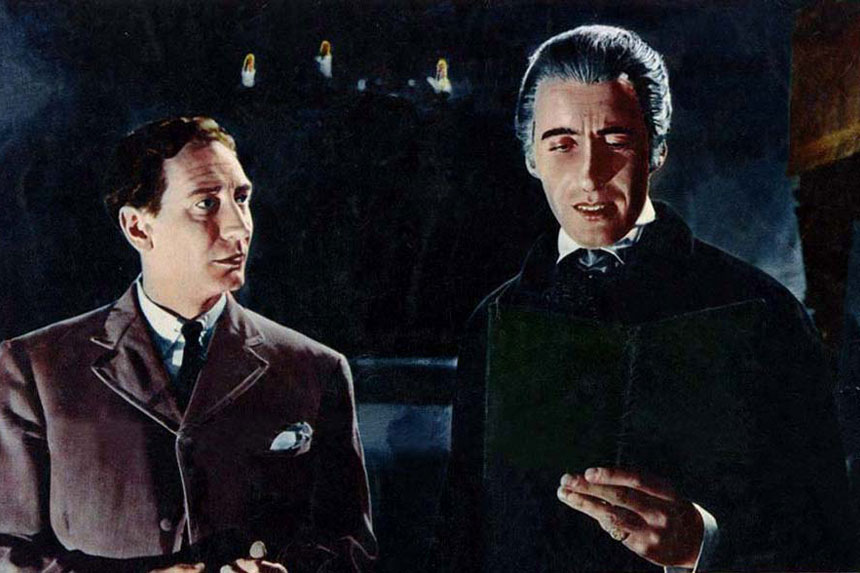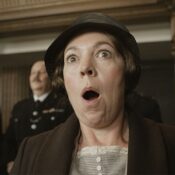Today, we’re looking at the best takes on Dracula from the big and small screens. Special thanks to Kyle Brownfield for ranking assistance. And don’t forget to check out our The Best Screen Vampires Who Aren’t Dracula.
20. Adam Sandler (Hotel Transylvania 1-3, 2012-2018)
Though he would jump ship before the fourth installment, Adam Sandler created a memorable, self-referential take on Dracula with his voice-work in the animated film series. Sandler was at his best in the first movie, balancing the depiction of Dracula as over-protective dad with his own resentment and fear of humans.
19. Al Lewis (The Munsters, 1964-1966; Munster, Go Home!, 1966; The Munsters’ Revenge, 1981; assorted cameos)
It’s easy to forget that Al Lewis’s Grandpa Munster was actually Dracula. And while the character was played for laughs with a smart-mouth demeanor, the writers kept a dark undercurrent to many of the jokes, such as alleging that he’d been married over 160 times. Lewis was so beloved in the role that he frequently cameoed as Grandpa in both live-action and animated guest spots, and even hosted TBS’s Super Scary Saturday afternoon movie block that ran from 1987-1989.
18. Rudolf Martin (Buffy the Vampire Slayer, 2000)
The Slayer meets The Count in Buffy the Vampire Slayer (Uploaded to YouTube by Magic Box HD)
Buffy slayed all manner of vampires during the show’s seven-season run, but she didn’t meet the Count until the fifth season premiere. True to the show’s iconoclastic nature, Buffy refused to believe Dracula was actually Dracula at first, noting how many times she’d encountered “fanboys” who called themselves Lestat. The episode functioned mainly as a Universal Studios send-up, with Martin affecting a Lugosi-lite accent and exercising some solid charisma.
17. Jonathan Rhys Meyers (Dracula, 2013)
Though series creator Cole Haddon has been honest about behind-the-scenes problems on the short-lived NBC series, it’s evident that the cast was good. With Thomas Kretschmann, Jessica De Gouw, and Katie McGrath as Van Helsing, Mina, and Lucy, respectively, you were in good hands. As for the Count, that was the rather excellent Johnathan Rhys Meyers, known for a lot of films and stand-out work in TV series like The Tudors and Vikings, who brought an aristocratic bearing to the proceedings.
16. Javier Botet (The Last Voyage of the Demeter, 2023)
Controversial pick! While much of the appearance of Dracula was CGI-rendered for the film, it’s the talent of Javier Botet, a 6’7” Spanish actor who has taken on many creature roles. As such, Botet imbued the truly interesting character design with life. And (spoiler) with the Count’s appearance in a more human, yet still monstrous, form at the end, Botet managed to inject a wicked playfulness to his character. Give us a sequel with Botet as that version, and he will climb the list.
15. Christian Camargo (Penny Dreadful, 2016)
Scene from Penny Dreadful, Season 3 Episode 9 (Uploaded to YouTube by Penny Dreadful)
The Dracula of Penny Dreadful, like many screen Draculas, first appeared under an alias. As zoologist Dr. Sweet (oh, the irony), he expressed a childlike fascination with animals, his first scene suggesting a new love interest for Vanessa (Eva Green). Camargo managed to cut an imposing figure without being showy, demonstrating his strength (such as easily lifting Josh Hartnett’s Ethan Chandler with one had by the throat) even as he spoke calmly and clearly. It’s an interesting performance in a show that’s loaded with them.
14. Claes Bang (Dracula, 2000 via BBC)
As Dracula is one of the most-filmed fictional characters of all time, it’s no surprise that new series featuring the Count come very frequently. It’s fitting that Steven Moffat, who modernized Holmes with Sherlock, would attempt to work some of the same magic on Dracula. With co-creator Mark Gatiss, Moffat assembled a three-episode series for the BBC featuring Claes Bang. Bang radiates danger and arrogance as this new incarnation of Dracula, but he also does the seductive and witty bits as well. Had the show run longer than three extra-sized episodes, he might have made a bigger mark on the role.
13. Michael Nouri (The Curse of Dracula/Cliffhangers, 1979)
Cliffhangers deserves its own article. The high-concept NBC series was a three-in-one anthology series where each episode featured a 20-minute segment of a different ongoing story in the mode of old-time movie serials. Stop Susan Williams was a modern Perils of Pauline about a journalist chasing an international conspiracy, and The Secret Empire was based on the Gene Autry-starring The Phantom Empire that crossed cowboys with a sci-fi underground civilization. And then there was The Curse of Dracula, set in 1979 San Francisco with the Count assuming the cover of a history professor. Although the show’s run was short, Dracula completed its story; the episodes were later re-edited into a pair of TV movies, Dracula ’79 and World of Dracula. Michael Nouri did stand-out work as the Count, shifting effortlessly between mild-mannered civilian identity and a (for ’70s TV) quite frightening take on Dracula.
12. Charles Macaulay (Blacula, 1971)
Charles Macaulay’s Dracula didn’t have a lot of screen time in Blacula, but he cuts a memorable figure. Seductive, evil, and . . . well . . . just plain racist, Macaulay’s Count immediately made you feel sympathy for William Marshall’s Prince Mamuwalde. Dracula betrayed the Prince, bit him, buried him, and cursed him with the name Blacula, all in the first few minutes. That was memorable.
11. Louis Jourdan (Count Dracula, 1977)
While this was another BBC adaptation, it took greater pains to be faithful to the original novel (except, of course, Lucy and Mina are sisters and they combine Arthur and Quincey and . . . well, that’s the movies. Anyway . . .) Jourdan’s Dracula was high on charm, but he still got the sinister part right. He also affected the long fingernails and hairy hands that were described in Stoker’s book. Overall, the film has been admired by critics and Stoker scholars for what it got right about the book and its performances, notably Jourdan’s.
10. Max Schreck (Nosferatu, 1922)
The full film of Nosferatu (Uploaded to YouTube by Timeless Classic Movies)
This one comes with an asterisk because Max Schreck played Count Orlok in the silent classic. However, Orlok really is Dracula; director F.W. Murnau sought permission to adapt Dracula from Bram Stoker’s widow, was denied, and simply just filmed the story with name and location changes. And Schreck pulled off one of the most visually memorable and striking takes on the Count ever. Murnau’s genius as a director was to let the lighting enhance the character, using tricks like showing Orlok emerge from darkness or composing shots where the long shadow of Orlok appears before the character does. Schreck only slides down the list because of the Dracula technicality, and we never hear him speak (although one actor who’s higher on the list elected not to speak for an entire film).
9. John Carradine (House of Frankenstein, 1944; House of Dracula, 1945; Billy the Kid vs. Dracula, 1966; Nocturna, 1979, plus Las Vampiras, 1969)
Thin of countenance and wide of range, John Carradine did about everything. From Biblical epics to Shakespeare to westerns to The Grapes of Wrath, from big-budget studio pictures to less-than-B movies, Carradine could do it all. With Bela Lugosi bouncing around other roles in the Universal Studios monster films, Carradine stepped in as Dracula in two memorable crossover pictures: House of Frankenstein and House of Dracula. He also took a campy turn as the Count in the old west in the fairly ridiculous Billy the Kid vs. Dracula and essayed a stand-in for Dracula (he was, sigh, Dr. Alucard) in Las Vampiras, one of many films that featured Mexican wrestlers (luchadores) versus monsters. In Nocturna, he played Dracula as grandfather to the title character in a disco-infused horror comedy. Through it all, Carradine played Dracula straight and scary, even if everything around him was bizarre.
8. Lon Chaney, Jr. (Son of Dracula, 1943)
Yes, it was called Son of Dracula. No, he was actually playing Dracula. Disguised as, you guessed it, Count Alucard, Lon Chaney had a good time in one of the rare Universal roles where he wasn’t covered in make-up. In fact, Chaney had the distinction of playing each of Universal’s “big four” in various movies: Dracula, the Frankenstein monster, the Wolf Man, and the Mummy. Here, Chaney’s performance was greatly enhanced by the direction of Robert Siodmak, who knew how to build scenes and take advantage of shadow.
7. Jack Palance (Bram Stoker’s Dracula, 1974)
Trailer for Bram Stoker’s Dracula (Uploaded to YouTube by Screenbound Pictures)
From his film debut in 1950 onward, Jack Palance made a career out of playing sinister figures. When Dan Curtis (of Dark Shadows and The Night Stalker) decided to do a TV-movie on the Count, he went to one of the most reliable bad men in entertainment. Palance brought it all to the Count: heightened emotionalism and heightened rage. It was a rock-solid Dracula turn from an actor who might not have been one you visualized in the part, but who delivered. He also met his demise in one of the most clever ways a Dracula has ever taken the dirt nap on screen (it combined a familiar weakness and a reference to the historical inspiration for Dracula, Vlad Ţepeş).
6. Klaus Kinski (Nosferatu the Vampyre, 1979)
Trailer for Nosferatu the Vampyre (Uploaded to YouTube by Scream Factory TV)
Few film relationships were as rewarding, or as combative, as that between actor Klaus Kinski and director Werner Herzog. The German mega-talents made five films together, fighting the entire time, and yet Herzog would memorialize his actor/antagonist in a documentary called My Best Friend. Their second film together, Nosferatu the Vampyre, was a reinvention of the silent classic, but writer-director Herzog was free to use the actual names of characters like Jonathan Harker, Lucy, and, of course, Dracula. Whatever volatile chemical mixture the relationship between Herzog and Kinski was, they made brilliant films together. Nosferatu, which they filmed in both German and English (yes, essentially two movies at the same time), was an outstanding take on the ideas of Stoker and the movie of Murnau. Kinski echoed Schreck’s performance but made Dracula his own with an unnerving, calculated performance. This was audacious filmmaking, and Kinski earned his place on the list.
5. Duncan Regehr (The Monster Squad, 1987)
Brought to you by pre-eminent 1980s action writer Shane Black (he created Lethal Weapon) and writer/director Fred Dekker (House; Night of the Creeps), The Monster Squad riffed on Universal Monsters movies by putting the creatures up against the titular squad, a group of teens who grew up on horror movies and Stephen King. The horror-action-comedy balanced out well, with Regehr doing the heavy lifting for evil. He chews more scenery than necks as he takes over every scene he’s in. As the kids say, he didn’t have to go this hard. And yet he did, gleefully trying to outright kill the kids in their treehouse with dynamite(!) and pursuing a spell to plunge the world into darkness. He was, without a doubt, a great Dracula.
4. Frank Langella (Dracula, 1979)
Like Bela Lugosi before him, Frank Langella played Dracula on stage before making the leap to film. Langella was nominated for a Tony for his 1977 Broadway turn. He almost passed on the movie version, but couldn’t resist playing against Laurence Olivier as Van Helsing. Leaning heavily on Gothic romance (and with a lot of changes to the book), director John Badham gave Langella free rein to be animalistic in both sexuality and savagery. Langella gave the Count tremendous physical presence and managed to be frightening on his own in a film where the best scare scene doesn’t even have Dracula in it.
3. Gary Oldman (Bram Stoker’s Dracula, 1992)
Trailer for Bram Stoker’s Dracula (Uploaded to YouTube by TrailersPlaygroundHD)
Francis Ford Coppola’s Bram Stoker’s Dracula wasn’t perfect, but it was great. Outstanding music by Wojciech Kilar, Oscar-winning make-up, a story that actually included all of the main characters in their novel-accurate relationship configurations, and a strong cast made it that way. But the main feature was the main character: Gary Oldman. Oldman had built a career on disappearing into the likes of Beethoven, Sid Vicious, Winston Churchill, Lee Harvey Oswald, and more, so to see him take on the Count in various forms (wizened old monster, Victorian dandy, wolf-form, man-bat hybrid) was stunning. Veering from righteous anger to duplicitous schemer to obsessed lover, Oldman played every shade available.
2. Bela Lugosi (Dracula, 1931; Abbott and Costello Meet Frankenstein, 1948)
Trailer for Dracula (Uploaded to YouTube by Rotten Tomatoes Classic Trailers)
He only properly played Count Dracula on screen twice, seventeen years apart, but Bela Legosi was identified with the part for the rest of his life. Lugosi first won notice as the Count on Broadway, and then by playing the part on the West Coast. He worked hard to get the studios to consider him for the part, and when he landed it, he made it immortal. Since that time, anyone imitating Dracula is basically imitating Lugosi. He put on the cape again for Abbott and Costello Meet Frankenstein, a crossover film that had the Frankenstein monster (Glenn Strange), the Wolf Man (a returning Lon Chaney, Jr.), and Lugosi’s Dracula run into the famous comedians. Even though it was played for laughs, Lugosi knew why he was there, and summoned the old dark magic one more time. Lugosi passed in 1956, but his Dracula lives forever.
1. Christopher Lee (Dracula aka Horror of Dracula, 1958; Dracula: Prince of Darkness, 1966; Dracula Has Risen from the Grave, 1968; Count Dracula, 1970; Taste the Blood of Dracula, 1970; Scars of Dracula, 1970; Dracula 1972 AD, 1972; The Satanic Rites of Dracula, 1973)
Trailer for Horror of Dracula (Uploaded to YouTube by Rotten Tomatoes Classic Trailers)
U.K. outfit Hammer Films set themselves up as the Universal of the ’50s, ’60s, and ’70s, going all in on their versions of the same classic monsters that took Hollywood by storm during the Great Depression. Like Universal, they deployed actors across franchises, with some actors playing multiple archetypal villains. And though he played the Mummy, Frankenstein’s monster, and Fu Manchu for Hammer, and portrayed a Bond villain (Scaramanga), a Star Wars villain (Count Dooku), a Tolkien villain (Saruman), and horror icon (Lord Summerisle in The Wicker Man), Christopher Lee will always be Dracula. With his tall frame, deep voice, and majestic demeanor, Lee commanded the screen. He carried an air of danger and experience; his World War II and post-war Nazi-hunting exploits led his friend and step-cousin(!), writer Ian Fleming, to base James Bond on him. Intelligent and well-read, Lee didn’t suffer foolishness near his work. In fact, he hated his lines for Dracula: Prince of Darkness so much that he refused to speak them; that’s right, Lee goes through the entire film without saying a word, and he’s still terrifying. Lee did seven films as Dracula for Hammer, occasionally facing off against the best Van Helsing (Peter Cushing), and played the character once in a 1970 German film, Count Dracula. For his sustained menace, his devotion to the role, and his overall commitment to being scary as hell, Christopher Lee is The Best Screen Dracula.
Become a Saturday Evening Post member and enjoy unlimited access. Subscribe now




Comments
Troy: a round of applause for remembering Cliffhangers!